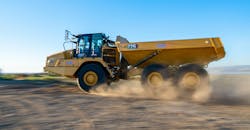The fact that autonomous vehicles have grown in popularity in recent years has little to do with people embracing the novelty. Instead, it’s a clear testament to the continued advances in the AI technology needed to safely operate the maturing category of vehicles. However, the real progress goes well beyond the occasional car you pass on our nation’s highways. It is the heavy equipment sector – including farm equipment – demonstrating the most immediate promise and potential.
SafeAI, a platform for autonomous heavy equipment, and Obayashi Corporation, a Japanese-based global leader in construction are in a strategic partnership to create autonomous construction sites, beginning with a pilot program on a U.S. construction site. Joining with one of the largest names in construction, SafeAI is demonstrating industrial autonomy in a real world situation and setting a standard for future autonomous heavy equipment. The news follows Obayashi Corporation’s strategic investment in SafeAI in November 2019.
Beginning in November 2020, SafeAI will operate an autonomous articulated dump truck, specifically the Caterpillar 725 articulated truck, demonstrating a vital function on the site: load-haul-dump cycles. The pilot will operate at a construction site in South San Francisco, CA.
"This pilot project is a great starting point," Bibhrajit Halder, founder and CEO of SafeAI tells IndustryWeek. “Once we prove its potential, we will take it to the site of an ongoing dam construction project,” he says. “Success here could be the tipping point in how equipment (haul truck, dozers, loader and excavators) is utilized on construction projects. We are starting off with the haul truck and dozer. Once it is working in a production capacity, we'll start to scale up, going from one project to another project throughout the entire construction community.”
Natural progression
Halder is no stranger to the power of AI and the challenges of bringing autonomous vehicles to fruition. Prior to founding SafeAI, he worked for Caterpillar as it started the autonomous mining project. He also worked on autonomous driving at Ford in Silicon Valley, and spent some time working for Apple on its Apple Car project. This experience ultimately led to SafeAI and its initial goal of retrofitting construction vehicle, enabling them to run more safely more efficiently with huge productivity gains.
And, there is a significant market prime for the type of automation and digitalization SafeAI offers. Globally, construction represents one of the largest sectors in the world economy, according to The McKinsey Global Institute –– $10 trillion is spent on construction-related goods and services yearly. America creates nearly $1.3 trillion worth of structures each year while Japan creates 11.1 trillion yen worth of construction orders. Yet the industry-at-large faces labor shortages, missed deadlines, and increasing costs. The COVID-19 pandemic has only accelerated these labor shortages –– 83 percent of contractors reported moderate to high levels of difficulty in finding skilled workers, causing them to turn down projects.
Autonomous heavy equipment uniquely addresses long held pain points of the construction industry by offering a safer, more productive solution that can operate 24/7 without risk of fatigue or injury. To that end, SafeAI has built an open, interoperable full stack autonomy platform that can be retrofitted across an existing fleet of industrial equipment. The interoperable model allows for integration with a range of ecosystem partners, bringing the entire vehicle onto the autonomous platform. SafeAI’s advanced autonomy is equipped to be deployed in a variety of construction use cases, while navigating highly dynamic worksites.
Scaling by use case
According to Halder, ongoing customer collaboration is a crucial component in building out its solutions, especially when considering the differences between individual use cases. The key? Ensuring that the journey towards a digitalized environment is holistic and not dominated only by the technology itself.
SafeAI applies project management disciplines to define and deliver solutions – solutions it ultimately builds on top of the SafeAI Framework — a highly flexible, safety-certifiable framework that meets standards developed for the rigorous requirements of the automotive industry.
“Our work with Obayashi paves the way for safer and more efficient construction sites across the world and reflects Obayashi’s commitment to innovative, connected technologies,” says Halder. “There is a critical need for autonomy outside of on-road vehicles –– the technology is ready today and we’ve built an ecosystem specifically for the construction and mining industries.”
“We are investing in autonomous solutions that we believe will play a critical role in our success both in the near term and also down the road. SafeAI has built a powerful autonomous ecosystem that ushers in safer, more productive worksites,” says Hiroto Sato, COO of Obayashi SVVL (Silicon Valley Ventures & Laboratory). “Throughout our partnership, we look forward to building operational and organizational structure to support this pilot and more deployments like it in the future.”
About the Author
Peter Fretty
Technology Editor
As a highly experienced journalist, Peter Fretty regularly covers advances in manufacturing, information technology, and software. He has written thousands of feature articles, cover stories, and white papers for an assortment of trade journals, business publications, and consumer magazines.
